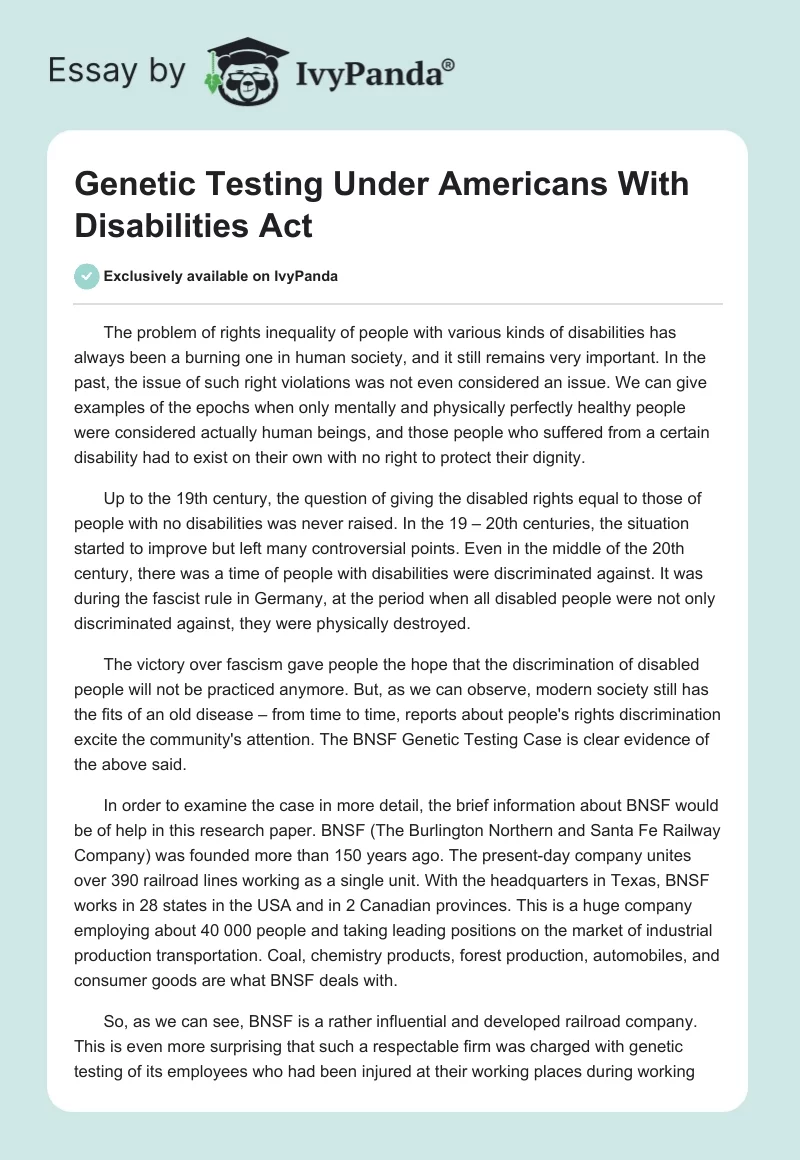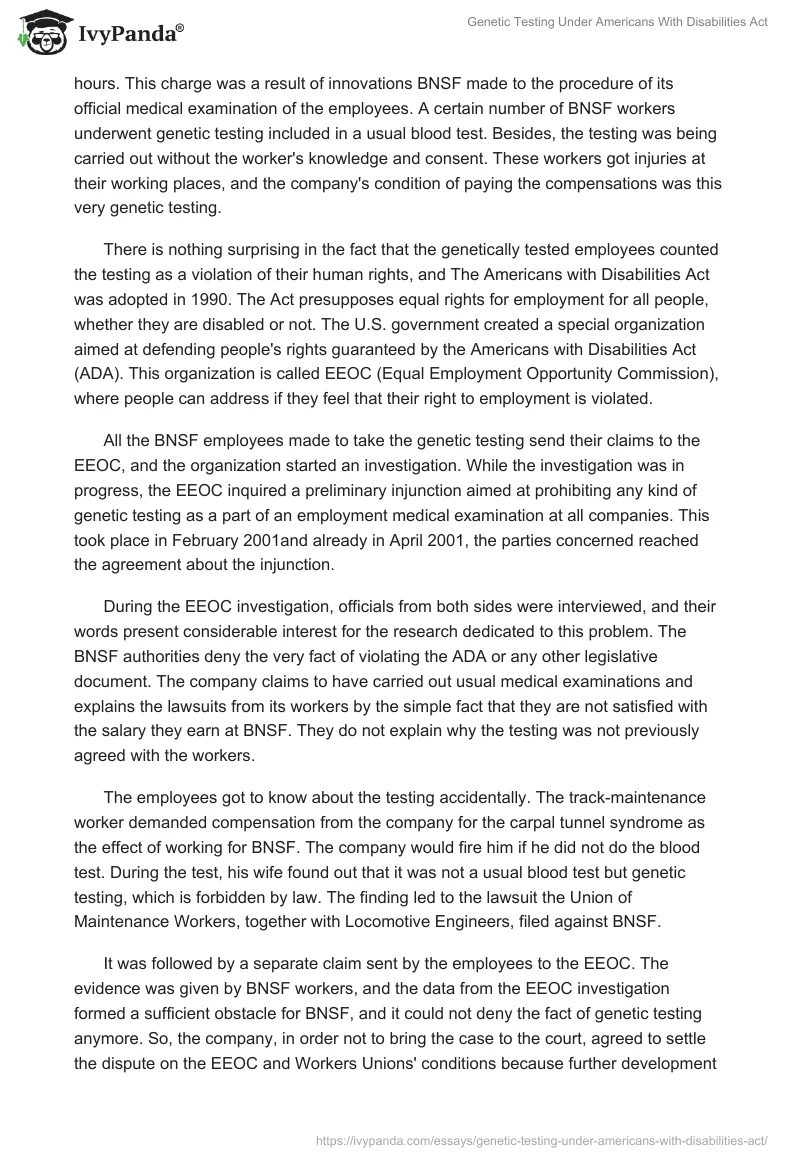The problem of rights inequality of people with various kinds of disabilities has always been a burning one in human society, and it still remains very important. In the past, the issue of such right violations was not even considered an issue. We can give examples of the epochs when only mentally and physically perfectly healthy people were considered actually human beings, and those people who suffered from a certain disability had to exist on their own with no right to protect their dignity.
Up to the 19th century, the question of giving the disabled rights equal to those of people with no disabilities was never raised. In the 19 – 20th centuries, the situation started to improve but left many controversial points. Even in the middle of the 20th century, there was a time of people with disabilities were discriminated against. It was during the fascist rule in Germany, at the period when all disabled people were not only discriminated against, they were physically destroyed.
The victory over fascism gave people the hope that the discrimination of disabled people will not be practiced anymore. But, as we can observe, modern society still has the fits of an old disease – from time to time, reports about people’s rights discrimination excite the community’s attention. The BNSF Genetic Testing Case is clear evidence of the above said.
In order to examine the case in more detail, the brief information about BNSF would be of help in this research paper. BNSF (The Burlington Northern and Santa Fe Railway Company) was founded more than 150 years ago. The present-day company unites over 390 railroad lines working as a single unit. With the headquarters in Texas, BNSF works in 28 states in the USA and in 2 Canadian provinces. This is a huge company employing about 40 000 people and taking leading positions on the market of industrial production transportation. Coal, chemistry products, forest production, automobiles, and consumer goods are what BNSF deals with.
So, as we can see, BNSF is a rather influential and developed railroad company. This is even more surprising that such a respectable firm was charged with genetic testing of its employees who had been injured at their working places during working hours. This charge was a result of innovations BNSF made to the procedure of its official medical examination of the employees. A certain number of BNSF workers underwent genetic testing included in a usual blood test. Besides, the testing was being carried out without the worker’s knowledge and consent. These workers got injuries at their working places, and the company’s condition of paying the compensations was this very genetic testing.
There is nothing surprising in the fact that the genetically tested employees counted the testing as a violation of their human rights, and The Americans with Disabilities Act was adopted in 1990. The Act presupposes equal rights for employment for all people, whether they are disabled or not. The U.S. government created a special organization aimed at defending people’s rights guaranteed by the Americans with Disabilities Act (ADA). This organization is called EEOC (Equal Employment Opportunity Commission), where people can address if they feel that their right to employment is violated.
All the BNSF employees made to take the genetic testing send their claims to the EEOC, and the organization started an investigation. While the investigation was in progress, the EEOC inquired a preliminary injunction aimed at prohibiting any kind of genetic testing as a part of an employment medical examination at all companies. This took place in February 2001and already in April 2001, the parties concerned reached the agreement about the injunction.
During the EEOC investigation, officials from both sides were interviewed, and their words present considerable interest for the research dedicated to this problem. The BNSF authorities deny the very fact of violating the ADA or any other legislative document. The company claims to have carried out usual medical examinations and explains the lawsuits from its workers by the simple fact that they are not satisfied with the salary they earn at BNSF. They do not explain why the testing was not previously agreed with the workers.
The employees got to know about the testing accidentally. The track-maintenance worker demanded compensation from the company for the carpal tunnel syndrome as the effect of working for BNSF. The company would fire him if he did not do the blood test. During the test, his wife found out that it was not a usual blood test but genetic testing, which is forbidden by law. The finding led to the lawsuit the Union of Maintenance Workers, together with Locomotive Engineers, filed against BNSF.
It was followed by a separate claim sent by the employees to the EEOC. The evidence was given by BNSF workers, and the data from the EEOC investigation formed a sufficient obstacle for BNSF, and it could not deny the fact of genetic testing anymore. So, the company, in order not to bring the case to the court, agreed to settle the dispute on the EEOC and Workers Unions’ conditions because further development of the conflict could seriously damage the company’s image among its customers and on the transportation service market on the whole.
The settlement of the employees’ claim cost BNSF $2.2 million paid to the workers made to take the genetic blood testing. But this is only a part of another settlement concerning the charges of the company’s Federal Employers’ Liability Act violation (an act which regulates a railroad employer’s liability to its employees for on-duty injuries). Added to the financial compensation, BNSF agreed not to make its workers undergo genetic screening and not to sanction the employees who had filed the claim against their employers.
The controversial points seemed to be settled, but the final decision was dependant on the solution made by the U.S. District Court for the Eastern District of Wisconsin, where the settlement was filed after the parties agreed on all the terms of the document.
The settlement of the claim was differently assessed by the sides of the conflict. The BNSF officials still refuse to admit the fact of violating any law by the company and say that BNSF voluntarily agreed to settle the claim in order to eliminate possible problems and so that to make the company’s work more fruitful. Richard Russack, the BNSF spokesman, confirmed that the company’s decision was nothing but another step to follow the long-term policy of the railroad firm.
On the contrary, the EEOC representatives claim their gladness for such a settlement of the issue. During the investigation, they stated that BNSF decisions based on unlawful genetic screening are inadmissible and contradicting the ADA. When the problem was solved, according to EEOC Chairwoman Ida L. Castro’s words, employers all over the country would understand what they should not do. They should give up the practice of genetic screening and discrimination against their workers.
The case of BNSF should be a kind of warning for all employers showing them the domination of law and human rights in society. The result of this case can be a precedent for lawyers to use in likewise situations in the future, and, besides, it has some law-making consequences – 22 states have already banned genetic screening as a part of the employment. Shortly after the BNSF case, other railroad companies refused the genetic blood testing, saying that this step will defend the employees from possible future genetic discrimination.
To express my personal opinion, the case of the BNSF employees had only positive consequences for the U.S. society and must positively affect the situation with the human rights defenders in the whole world. The problem of any kind of people’s discrimination, whether racial or genetic, must be solved immediately as soon as it appears and by the strictest means. This will help us achieve two goals at once: show the punishment awaiting every human rights violator and put the development of human rights defense policy on a higher level.
In conclusion, I would like to say that people’s discrimination is an inadmissible phenomenon in modern society. The times of its existence have gone to history long ago, and mankind should do its best not to let it come into our lives once again. Lessons of history should not be forgotten, and today’s manifestations of this issue’s existence must serve as an impact for further work on its elimination.
The BNSF case shows that people are still prejudiced against others and a lot of work in the direction of a jural society remains to be done. The struggle of the workers and the EEOC aid is a nice example of how the human rights violations can be fought. In this case we can observe a fruitful collaboration of people and the authorities appointed to defend their rights. The court system also demonstrated its strength being dispassionate and objective.
The immediate results of the BNSF case can be vividly seen – lawmakers became interested in the issue and respective laws banning the genetic discrimination emerge in many states. Numerous companies launch genetic testing banning as an integral part of their policies. The attention of the community is now concentrated on this problem and this makes the problem’s solution clearer and easier to reach.
Works Cited
BNSF and EEOC Settle Genetic Testing Case Under Americans with Disabilities Act
FORT WORTH, Texas, 2002. Web.
Kaback M, Lim-Steele J, Dabholkar D, Brown D, Levy N, Zeiger K: Tay-Sachs disease–carrier screening, prenatal diagnosis, and the molecular era. An international perspective, 1970 to 1993. The International TSD Data Collection Network. JAMA 1993; 207: 2307-2315.
Lewin, Tamar. (2002). National Briefing | Washington: Accord On Genetic Tests. Web.
Promoting Safe and Effective Genetic Testing in the United States. (2006). Web.
Public Law 100-578: Clinical Laboratory Improvement Amendments of 1988. 1988;42 USC 263a.
Schafer, Sarah. (2001) Railroad Agrees to Stop Gene-Testing Workers. By Washington Post Staff Writer Page E01. Web.
Weber B: Breast cancer susceptibility genes: Current challenges and future promises. Annals of Internal Medicine 1996;124:1088-1090.


